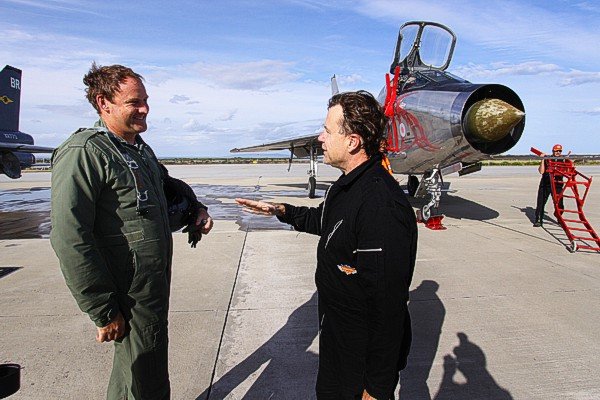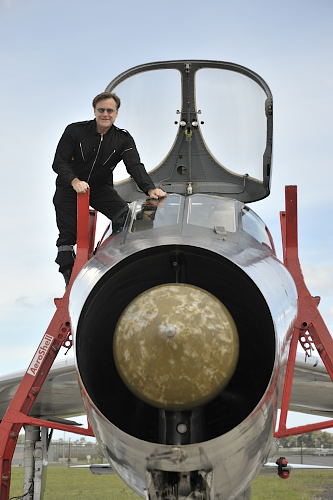A year ago this week something happened in South Africa I can't shake, even after writing about it ad infinitum. It still sticks in my craw. But the lessons are clear: Just because you pay lots of money for adventure doesn't mean it's safe. And when your number's up, it is up.
"Jim, if I say, 'EJECT, EJECT, EJECT,' and you don't pull this immediately, nothing but a smoking hole will be left in the space next to you." Test pilot Dave Stock is pointing to the ejection chord under my seat. Grinning, he confides he wouldn't eject first (and leave a smoking hole next to me!), but he is trying to reinforce urgency if our Cold War-era English Electric Lightning aircraft should get into trouble. Stock tells me I'm safer here than in a commercial jetliner precisely because of the ejection seat, which has a parachute attached. In a 737, there's no backup if things go suddenly wrong.
We're at Thunder City, a Cape Town air base famous for thrilling tourists in ex-military aircraft. While Stock preps me, his ground crew straps me in to the two-seat cockpit. We are about to fly side-by-side to Overberg, known for its spectacular air shows. I'm outfitted in a flight suit, boots, helmet and oxygen mask. Is this how Chuck Yeager, first to break the sound barrier, felt before his flight in 1947? We're scheduled to go supersonic, too, but in a plane built later to go faster than Yeager's Bell X-1.
I had flown supersonic before, so I'm no stranger to exotic aircraft. In 1999, I rocketed to 84,000 feet above Moscow at Mach 2.6 in a MiG-25 Foxbat with Space Adventures. The Lightning won't take me as fast, or as high, but it will do something potentially more unsettling: rapid vertical ascent coupled with aerobatics. Stock tells me that if I get sick to pull my oxygen mask to the side, unzip the top of my flight suit and vomit there. A South African Air Force veteran, Stock holds his share of records. In 2006 he attempted to break his own 9,000-meter vertical climb mark in this very aircraft with Richard Branson aboard, only to fall short by a few seconds.
After takeoff we pivot to vertical, then, with full afterburners, quickly climb to 10,000 feet. I fight G forces and maneuver my head to watch the ground recede, as if we are in a missile. Then we do a roll, level off and begin a gradual climb. At 30,000 feet, Stock begins to accelerate again. Supersonic speed should only be achieved up high because a sonic boom near the ground would break too many windows below.
As the clouds recede, the sensation of speed becomes hard to judge. When we approach the speed of sound, Stock gives me the stick. I ease it forward. When the speed gauge flashes Mach 1, there's slight turbulence, then the ride becomes smooth. At 40,000 feet we hold steady at Mach 1.07. Fifteen minutes later, as we near Overberg, Stock does a 360-degree roll, we descend and I brace for landing. But suddenly he pulls the aircraft up, and we go into a series of gut-wrenching rolls, turns, dives and I-don't-know-what's.
For eight minutes, my body is wracked with 5-G jolts that pin my head to my lap, then against the seatback. Stock does things in the aircraft (and to my stomach) I can't believe. Upon landing, he tells me that to qualify for the air show the next day he had to prove the plane airworthy by performing a full aerobatics dress rehearsal. "You may not realize it now, but in a few days you'll see this as life-changing," he says. At the time I'm sure he had no idea how his statement would play out.
The next day, I saw a story in the Cape Town Times about the air show. A fighter jet developed hydraulics problems, and the pilot managed to steer away from the crowd of 40,000. After three attempts he said, "Ejection seat failure" and crashed. The pilot was Dave Stock and the aircraft was the Lightning I had just flown in.

Fast-forward a year. I still keep asking myself, had the hydraulics failed hours earlier, on my flight, would I be alive? What happened to Stock (left, with author in above photo) certainly goes with the territory. He understood the risks and, in the end, died doing what he loved. Wealthy clients, who often take such risks nonchalantly, also should not forget the obvious: Real adventure always involves risk.
(NOTE: After a decade of service, Mike Beachy Head shut down his Thunder City operation this summer, apparently unable to survive repercussions from the accident. As such, the $17,000 Lightning flights are no longer available.)
